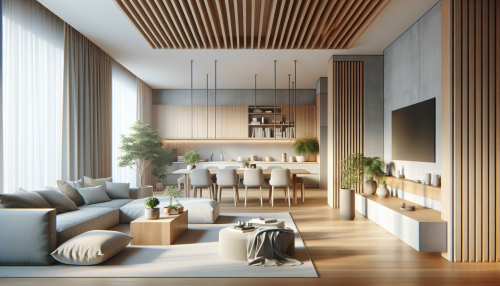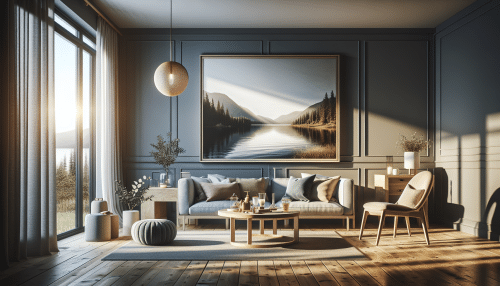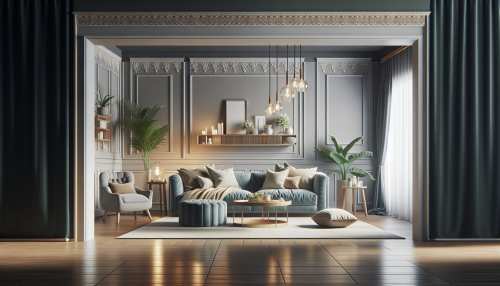Unique Ways You Can Refresh Your Home Decor
Olivia Morgan November 4, 2025
If you’re interested in lifestyle and entertainment, home decor changes can make a real difference. This guide explores creative updates, decorating hacks, and style ideas for a vibrant home—without breaking the bank. Learn how to express your personality through interior choices using budget-friendly tips that blend aesthetics with function.
Creative Color Palettes That Change Everything
Color can transform any home environment instantly, and experimenting with bold palettes is a growing interior design trend. Whether opting for calming pastels or vibrant pops, each hue sets a distinct mood. Changing wall color or simply adding colorful accents like cushions or rugs is a strategic way to revitalize your space. Many decorators recommend using a color wheel to find complementary tones for both harmony and drama. If you want to foster tranquility, natural earth tones or soft blues could be incorporated effortlessly into your living area or bedroom. For a more stimulating vibe, try brighter shades like citrus or magenta—these work great in creative nooks or home offices where increased energy is a plus. Reimagining your color scheme is an inexpensive move that opens endless possibilities for fresh looks and improved ambiance. Major décor resources and color theorists agree—when thoughtfully applied, color elevates style and mood in equal measure (https://www.apartmenttherapy.com/color-theory-37187215).
Introducing new color themes doesn’t require a full renovation. Sometimes, a striking piece of wall art or a few updated accessories are all that’s needed to create a bold effect. For renters, removable wallpaper or adhesive decals allow for expressive visuals with zero risk. Changing pillow covers or lamp shades seasonally can inspire recurring transformations. Home bloggers and professionals often highlight art as a key design anchor: it’s both an investment in atmosphere and an instant talking point. Abstract canvases or geometric prints can highlight personality and guide the rest of a room’s styling. Experts say beginning with these small, convenient updates helps build the confidence to embrace color. It becomes easy, enjoyable, and low stress. (https://www.hgtv.com/design/decorating/color/10-tips)
Color is powerful beyond just looks. Designers note that colors can impact energy, focus, and relaxation—important elements of comfortable living. Soft greens and sage are frequently used in wellness-oriented interiors for their calming influence. Creative types, meanwhile, often gravitate to bolder palettes that stimulate creativity and spark conversation. Color psychology plays a role in elevating or soothing moods, all through easily accessible décor changes. Don’t worry about perfection: experimenting is half the fun, and there’s flexibility to refresh whenever inspiration strikes. Read more about mood and design synergy on authoritative décor sites and in industry publications for a deeper dive into palette planning techniques. (https://www.psychologytoday.com/us/blog/design-your-path/201808/home-decor-and-your-mental-health)
Budget Upgrades With High-End Impact
Refreshing your home need not stretch your finances. There are many effective, stylish updates that cost surprisingly little, yet create a substantial impact. Secondary lighting, for example, adds depth and drama without a complete overhaul. Consider plugging in a statement floor lamp or LED strip under shelving for instant ambiance. Swapping old hardware—like cabinet knobs or doorknobs—with modern finishes also yields a refined effect. DIYers benefit from tutorials that make upgrades approachable and enjoyable. Even with a small budget, one can find ways to upgrade and personalize living spaces while remaining financially responsible. (https://www.goodhousekeeping.com/home/decorating-ideas/g3037/budget-decorating-ideas/)
A popular trend involves updating textiles. By switching out throws, blankets, and curtains, you introduce fresh textures and patterns that breathe new life into any setting. Rotating your décor with the seasons keeps things interesting—fluffy knits for winter, breezy linen in summer. Upcycled materials have also become mainstream, letting stylish users reduce waste while refreshing interiors. Local thrift stores or online marketplaces can be treasure troves for unique, affordable finds that elevate a room’s personality. Textiles, in fact, are among the most adaptable décor elements. Their tactile nature changes a room’s comfort level and visual appeal, making them a favorite for budget-conscious home stylists.
Simple fixes can have major effects. Rearranging furniture, for instance, is entirely cost-free yet dramatically improves flow and function. Pulling a sofa away from the wall or repositioning side tables changes the dynamic instantly. Experts suggest starting with a blank slate by temporarily clearing items and then reimagining each piece’s placement. If you’ve chosen multi-use furniture—fold-out desks, storage ottomans, extendable tables—you’ll find many opportunities to refresh. As function and form align, spaces often feel both bigger and more welcoming. Creativity, not cash, is the secret ingredient in successful home updates.
Indoor Plants and Green Spaces for Wellness
Houseplants do more than beautify interiors—they promote well-being. When placed thoughtfully, indoor greenery helps purify air and create a restful, natural vibe in any room. Snake plants, pothos, and peace lilies are celebrated choices for beginners and experts alike. Wellness studies link the presence of plants to lower stress levels and increased productivity, making them a high-value addition for both design and health. They bridge the gap between the built environment and the outdoors, forging a relaxing sanctuary just steps away. Care routines can be simple; even low-light plants add meaningful green touches.
Designers increasingly use plants to add movement, contrast, and height to interior layouts. Cascading vines on bookshelves and sculptural fiddle leaf figs in corners introduce organic shapes that soften rigid architecture. Hanging planters and living walls make use of vertical space—a plus for compact homes and apartments. The biophilic design trend blends nature with modern living, proving popular across a range of home styles. Specialized nurseries and online resources offer advice for every skill level so anyone can integrate more green space indoors with minimal effort.
Houseplants can be matched to every lifestyle, from busy urban dwellers to garden enthusiasts. Hardy varieties require little attention but still yield big returns in visual refreshment and atmosphere. Wellness experts suggest that cultivating green spaces at home can have meditative benefits, grounding residents in routines that nurture both environment and mind. The positive psychological effects are repeatedly cited in environmental health research. Even a single plant, placed near a workspace or entryway, radiates a mood-lifting effect worth exploring.
Personalizing Your Space With Art and DIY Projects
Custom art and personalized décor say a lot about style and story. Many people are rediscovering crafts—and with good reason. Framed photos, canvas abstracts, or handmade ceramics instantly elevate a space, making it feel distinctively ‘you’. There are endless routes to creative expression, from painting DIY wall murals to simple macramé hangings. Embroidered cushions, upcycled jars, or even a hand-painted accent wall showcase creativity on a practical scale. The broader trend, often called ‘slow decorating’, encourages individuals to build collections over time, focusing on cherished objects rather than instant makeovers. Shared experiences, souvenirs, and family heirlooms also add narrative depth that can’t be bought.
Those new to DIY will find digital resources and step-by-step guides for all skill levels. From mosaic tile trays to stenciled plant pots, countless projects can be completed in a weekend. This creativity-in-action supports sustainability and reduces reliance on mass-produced items. Community workshops or online classes also bring like-minded hobbyists together, fostering friendships and skill-building in an enjoyable setting. Whether aiming for fun or sophistication, DIY projects inject personality and conversation starters into home life.
Displaying art—and rotating it regularly—keeps interiors fresh. Experts say grouping artwork thematically or by color creates coherence, even with eclectic collections. Building gallery walls or simply propping a statement piece on a shelf shows off both taste and individuality. Art works as an anchor for evolving styles, allowing easy updates without larger investments. Many report higher levels of satisfaction when surrounded by self-chosen pieces or works created by friends and family, strengthening personal connections in daily living spaces.
Smart Storage and Decluttering Tricks You Might Not Expect
Organized spaces are not only visually appealing but can have real effects on clarity and mood. Experts believe clutter reduction is core to modern home enjoyment. Hidden storage solutions, like under-bed bins or furniture with built-in compartments, make tidying simple. Vertical shelving and wall-mounted hooks are smart ways to multiply square footage in smaller homes. Even open baskets—arranged artfully—add both style and utility. A streamlined area fosters rest, productivity, and easy maintenance. Many design consultants advocate decluttering before investing in new decor, since editing a space first highlights its true potential.
Storage can be as decorative as it is useful. Woven baskets, sleek boxes, and vintage trunks double as elegant furniture. Open shelving also lets cherished books, ceramics, or plants shine while keeping essentials in order. Strategically placed mirrors and glass storage offer depth and brightness, visually expanding rooms. Family-friendly solutions like labeled bins or low shelving make organizing easier for everyone in the household. It’s all about balancing aesthetics and practicality for a home that consistently feels inviting and easy to live in.
Maintaining clutter-free areas involves ongoing habits. Design pros suggest routine assessments—removing unused items each month, rotating favorite accessories, and even digitizing paperwork. Some turn to the minimalist philosophy, focusing on only the most valued objects. Others mix maximalist collections with strict organization for curated, storied displays. Regardless of style, the right storage approach ensures every refresh lasts longer and is genuinely enjoyable. The process is as individual as the people living in each space.
Making the Most of Light and Space in Your Home
Natural light works wonders in interior spaces. It makes rooms larger, airier, and more joyful—crucial qualities for a welcoming home. Maximizing sunlight starts with clean windows and minimal window coverings. Sheer curtains or blinds are recommended for those seeking both privacy and brightness. Reflective surfaces such as mirrors and glossy finishes also amplify available light, especially in smaller rooms. Even the placement of plants and art near windows can play up glowing effects correctly. Professionals often advise walking through each space at different times of day to assess natural light and plan accordingly.
Artificial lighting is just as critical for function and mood. Layered lighting—a mix of overhead, task, and accent lights—lets residents adapt ambiance on demand. Modern fixtures, smart bulbs, and adjustable lamps offer flexible solutions for any home activity, from working to relaxing. Color temperature matters as well; warmer bulbs create cozy nooks, while cooler options help focus in work areas. Designers suggest tailored lighting for each room so tasks and leisure are equally supported.
Finally, space planning maximizes comfort and movement. Arranging furniture to fit natural pathways, finding dual-use pieces, and keeping sightlines open all improve everyday living. Transparent furnishings and light paint colors keep tight spots from feeling cramped. A sense of flow increases usability and invites guests to linger. It’s ultimately about making every square foot feel both useful and delightful—no matter the size of your home.
References
1. Apartment Therapy. (n.d.). Color Theory: How to Use the Color Wheel for Decorating. Retrieved from https://www.apartmenttherapy.com/color-theory-37187215
2. HGTV Editors. (n.d.). 10 Tips for Adding Color to Your Space. Retrieved from https://www.hgtv.com/design/decorating/color/10-tips
3. Psychology Today. (2018). Home Decor and Your Mental Health. Retrieved from https://www.psychologytoday.com/us/blog/design-your-path/201808/home-decor-and-your-mental-health
4. Good Housekeeping. (n.d.). 70 Super Simple Budget-Friendly Home Decor Ideas. Retrieved from https://www.goodhousekeeping.com/home/decorating-ideas/g3037/budget-decorating-ideas/
5. Environmental Health Perspectives. (2015). A Room with a Green View: The Importance of Nature for Mental Health. Retrieved from https://ehp.niehs.nih.gov/doi/full/10.1289/ehp.122-A27
6. The Spruce. (n.d.). 20 Decluttering Tips to Maintain an Organized Home. Retrieved from https://www.thespruce.com/declutter-every-room-in-your-home-2648002





